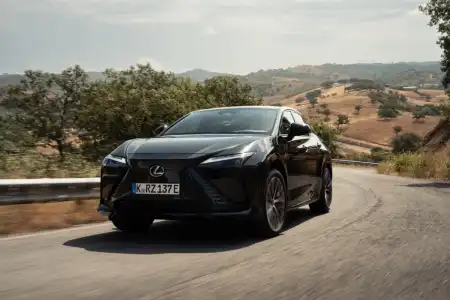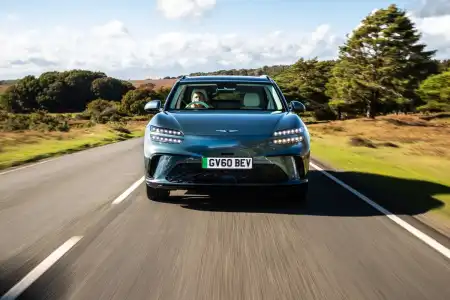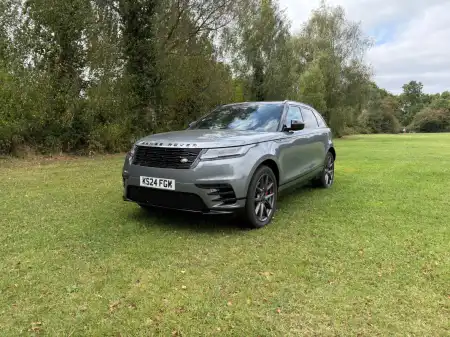- Dynamic performance and a range of 400 miles between filling up
- Great looking car and packed with technology
- New model is about 24 per cent cheaper than first generation cars and brings many tax saving benefits
- The lack of infrastructure to re-fill the car
- Pricey outlay, especially at the top end of the range
- People are cautious about embracing newer power sources
Introduction
Toyota has been working on developing hydrogen fuel cell electric vehicles (FCEV) since 1992 and the first Mirai was launched to various world markets in 2014.
However, the latest second-generation Mirai really raises the bar with a 400-mile range between filling up, great styling, bundles of top notch technology and the added benefit of zero emissions. It only emits water.
Although the infrastructure is woefully lacking compared to the likes of Germany, it is increasing gradually especially in larger cities where bus companies and council-run vehicles are beginning to adopt the cleaner technology.
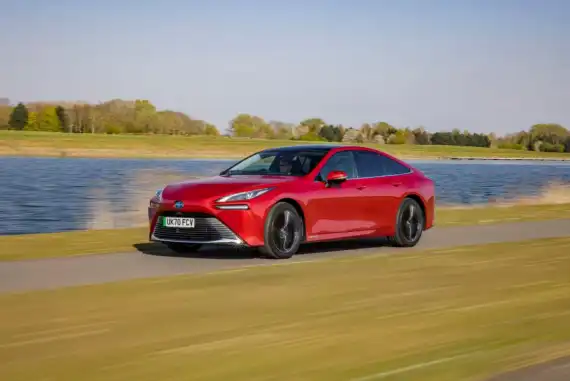
Ride Handling
When it comes to ride and handling, the new Mirai is leaps and bounds ahead of its predecessor. Once again, this is down to the clever packaging of the hydrogen tanks that has made the car far more poised and balanced.
There is Active Cornering Assist that automatically improves the stability in high-speed cornering by applying braking force to the inside rear wheel so the drive torque is increased on the outer rear wheel – this also helps any understeer issues.
In addition, Braking Control in high-speed cornering helps to reduce the risk of an oversteer spin. If driving in strong cross winds, this system will again apply braking force to keep the car stable and true to its course.
The driver can select a brake driving mode that replicates the effect of engine braking using a manual transmission. This provides stronger deceleration and regenerative braking when speed control is needed on a long downhill gradient for example. The function is quickly cancelled by pressing the accelerator pedal.
The Mirai feels beautifully balanced and that low centre of gravity, along with excellent stability, means it can be driven enthusiastically through fast moving B roads and twisting country lanes with confidence. It grips the surface like glue and there is next-to-no sign of any body sway.
On The Road
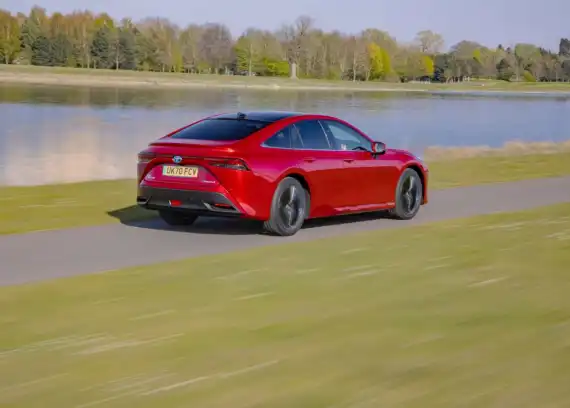
Performance
The new second-generation Mirai is a hydrogen fuel cell-powered family saloon that is built on the company’s GA-L platform. This has allowed the car to grow in size, improve its range between topping up and increase the driving pleasure considerably.
It is available in three richly-equipped trim levels called Design, Design Plus Pack and Design Premium Pack. We tested the range-topping Design Premium Pack model costing £64,995.
The car now features three high-pressure hydrogen tanks rather than two, and their positioning, along with a smaller battery that sits behind the rear seats, contributes to the car’s lower centre of gravity. This in turn, aids the ride and handling. Factor in the 50:50 front to rear weight distribution, and the Mirai is beautifully balanced offering plenty of grip through the country lanes.
With a total power output of 180bhp and 300Nm of torque, the Mirai can sprint from 0-62mph in 9.0 seconds – which is 0.6 of a second quicker than the previous model and it tops out at 108mph. Those figures may not sound that exciting, but the acceleration is instant and it feels much faster when the car is cruising effortlessly at national speed limits on motorways.
The acceleration from a standing start is impressive and it’s a car that can cope with sharp bursts of pace to overtake slower-moving vehicles. It is also easy to manoeuvre in busier town settings where the Advanced Parking Assist on the top model will take care of any parking issues for you.
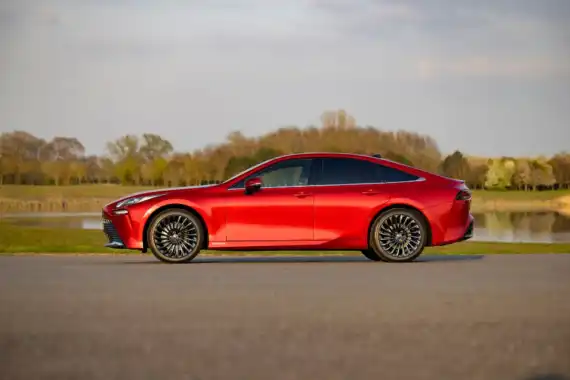
Styling
The Mirai is rear-wheel drive, four-door saloon that boasts dynamic styling with a wide front and rear end, low centre of gravity, a trapezoidal lower grille, shark fin antenna and front lights that are arranged in a two-tier design with the L-shaped daytime running lights extending into the front wings.
At the back of the car, the rear light units extend from left and right meeting at the centre where the Toyota badge is positioned.
The Design Plus Pack and Design Premium Pack cars gain puddle lights integrated into the door mirrors and the top model also features a panoramic roof with power sunshade, bi-tone paint finish with a black roof, rear privacy glass and 20-inch alloy wheels with black painted rims and a turbine pattern. Other trim levels have 19-inch wheels.
The interior is pure quality with a very modern layout. The upholstery ranges from fabric to synthetic leather to black semi-aniline leather depending on the specification and there is piano black and satin chrome trim inserts, ambient lighting, a perforated or leather steering wheel and Mirai scuff plates.
The cabin is beautifully insulated against road surface or wind noise and, for effect, there is an active sound control system that delivers noise through the speakers depending on the throttle use.
New Mirai features a multi-link front and rear suspension system in place of the previous front MacPherson struts and rear torsion beam arrangement. This set-up is high mounted at the front and low at the rear to provide a high level of stability and ride comfort.
In The Car
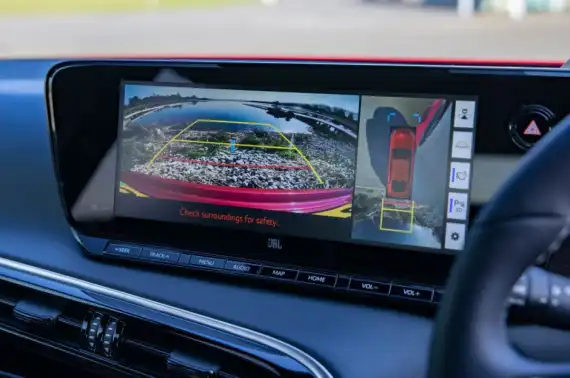
Behind the Wheel
The high-end Design Premium Pack model has a powered driver’s seat whereas the Design and Design Plus Pack versions are adjusted manually. There is plenty of movement on the steering wheel so finding the perfect driving position is a breeze.
The Mirai is certainly a relaxing car to drive with all controls, dials and readouts well positioned for ease of use. The all-round visibility impresses too although the rear windscreen is quite narrow due to the dynamic styling of the car. There is a digital rear-view mirror though that can be switched on and that offers a clear camera view of what’s going on behind the car. A Panoramic View Monitor displays a 360-degree view of the vehicle’s surroundings which is great for parking near high kerbs.
On-board technology is of a high standard with all versions boasting the Toyota Touch 2 multimedia system with a 14-speaker JBL sound system, Apple CarPlay or Android Auto smartphone connectivity, heated seats, a navigation system, dual-zone air conditioning, reversing camera, LED headlights with automatic high beam, DAB radio, Bluetooth, four USB ports and lots more besides.
Design Plus Pack models also feature a heated steering wheel, intelligent parking sensor, ambient lighting and blind spot monitor while the range-topping Design Premium Pack gains the likes of a panoramic glass roof, head-up display, wireless phone charger, heated and ventilated front and outer rear seats and power steering wheel adjustment.
The cabin is bright, upmarket and clutter-free with a 12.3-inch multimedia infotainment screen that flows neatly into the driver’s display screen. All the switches and controls are well laid out and kept quite small in size, but they are easily located as they are cleverly grouped in different zones depending on their function.
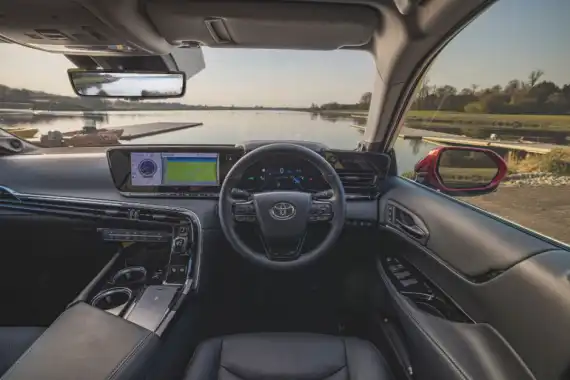
Space & Practicality
The dimensions of the second generation Mirai are much larger than its predecessor and that not only improves the appearance, it also means there is extra space within the car.
This has been achieved as the new Mirai is based on Toyota’s flexible GA-L platform. This has resulted in the fuel cell stack and drivetrain components being repackaged in a far more efficient way. As a result, the Mirai is now a five, not four-seater car and it is fitted with three high-pressure hydrogen tanks rather than two.
It can now hold 5.6kg of hydrogen compared to 4.6kg on the outgoing model and has an improved driving range of up to 400 miles between filling up – a process that takes minutes similarly to traditional fuel pumps.
New Mirai has grown too – it is 85mm longer, 70mm wider, with a 140mm longer wheelbase. But its height has been reduced by 65mm so it has a more dynamic appearance.
The boot is deep in its design and can swallow 321 litres of kit with under-floor and side storage options, and there is also an illuminated glovebox, door bins, a sunglasses compartment, driver and passenger seatback pockets, a rear console box, central cubby box and cup holders.
There is a button to eject any water that has been built up during journeys, which will not be that much so don’t expect a flood.
Ownership
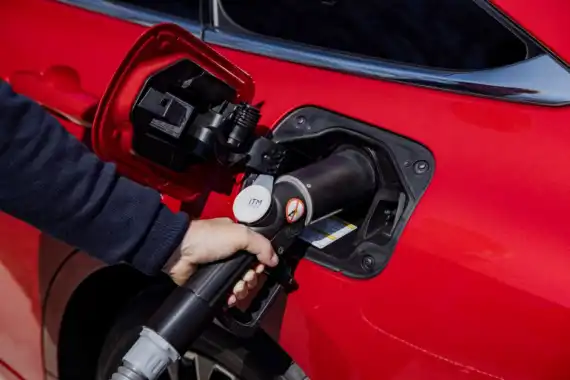
Running Costs
There are three Mirai trim levels called Design, Design Plus Pack and Design Premium Pack priced at £49,995, £53,995 and £64,995 respectively.
The cost of filling up the Mirai would be similarly priced to a petrol model and the car can travel about 400 miles once topped up. The main issue would be making sure you have planned your route to incorporate visits to areas where the hydrogen fuel is available, which for now tends to be the busier cities. There are currently 11 locations in the UK which compares to 90 in Germany, so we are falling behind with the infrastructure to cope with this latest technology.
However, with zero carbon emissions, there are good financial incentives especially to business drivers. All trim levels have a Benefit in Kind rating of just one per cent and a zero Vehicle Excise Duty charge.
The costs for fully maintained business contract hire, inclusive of servicing, have just been released and are impressive with Design models costing £435 per month, Design Plus Pack £450 and Design Premium Pack £609 – all exclusive of VAT.
Insurance ratings for the new Toyota Mirai are from group 34.
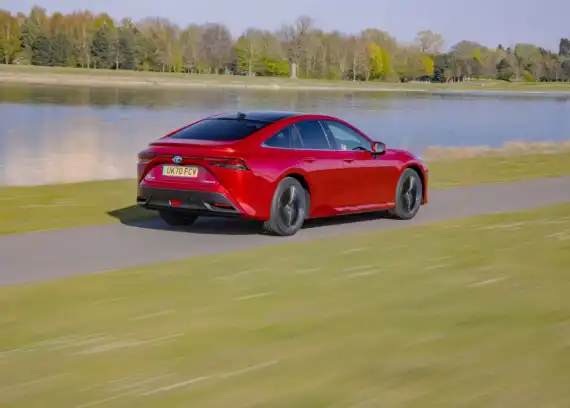
Quality & Reliability
Toyota has an excellent reputation the world over for developing cars that are reliable and the manufacturer frequently features at the top end of customer satisfaction surveys.
The fact that the Japanese marque has decades of experience developing hybrid technology means it is the leader in a chasing pack, so it comes as little surprise that it is embracing the latest hydrogen fuel cell technology in the form of the Mirai.
The interior is very well constructed with all the dials, switches and controls looking and feeling sturdy. The upholstery is high-end and should also survive the test of time.
Obviously, the FCEV technology is still fairly new so its reliability cannot be predicted at this stage.
However, Toyota still offers one of the best warranty packages in the business of five years or 100,000-miles. In addition, every new Mirai has an eight-year warranty on key fuel cell vehicle components and a 10-year, 150,000-mile hybrid battery warranty.
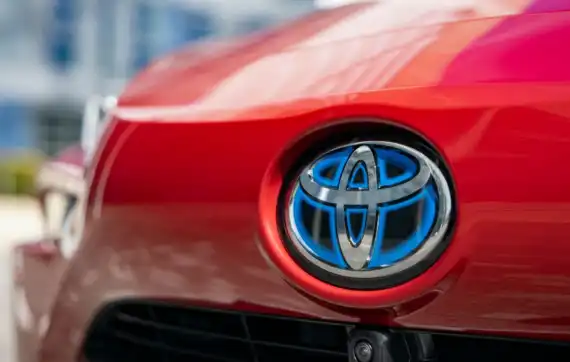
Safety & Security
The new Mirai is packed with safety kit via the Toyota Safety Sense suite of technologies to protect occupants, other road users and to help prevent accidents from occurring in the first place.
There is intelligent adaptive cruise control with lane departure alert and lane trace assist, a pre-collision system with an emergency steer function, automatic high beam, vehicle stability control, traction control, driver attention alert, hill-start control, plus Isofix child seat fixtures and a full suite of seven airbags.
Additional safety kit, according to the trim model, includes rear cross traffic alert with auto brake and intelligent clearance sonars, also with auto brake and a blind spot monitor.
Clearly, great consideration has been given to the safety of the hydrogen tanks which, together with the fuel cell stacks, are protected in the event of a collision with a strong body frame that absorbs impact and additional aluminium reinforcement to protect the front end of the car. In addition, sensors will detect any hydrogen leakage and warn the driver via the instrument display.
The Mirai is fitted with an anti-tamper alarm, intrusion alarm and sensor, childproof door locks, remote door locking and an immobiliser.

